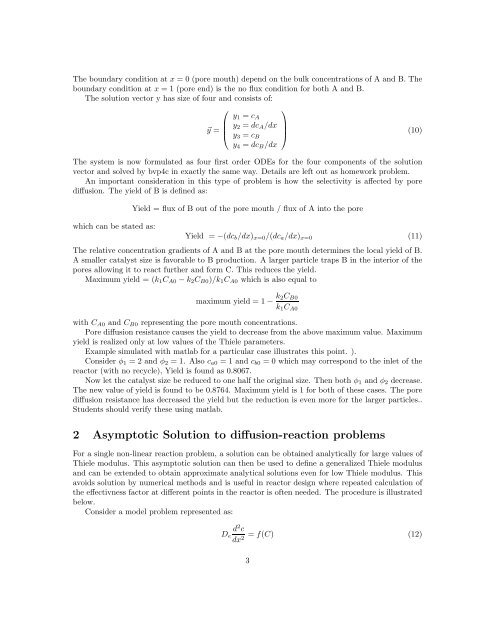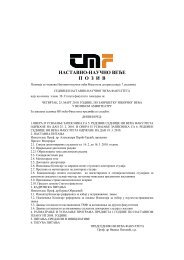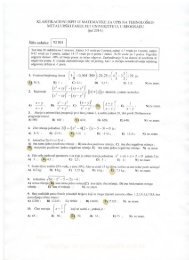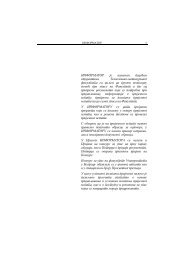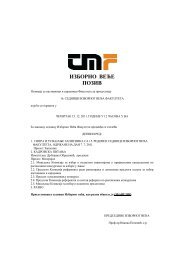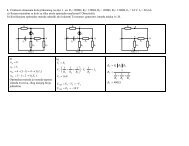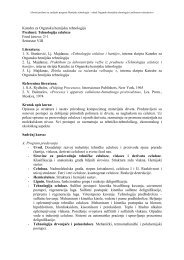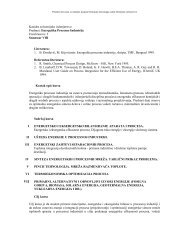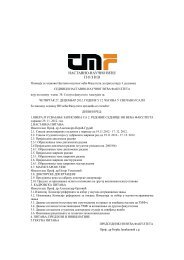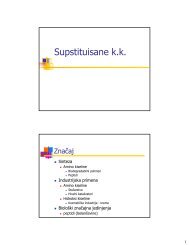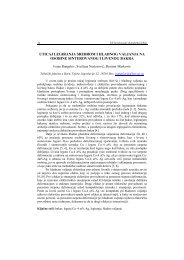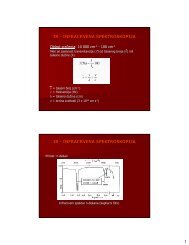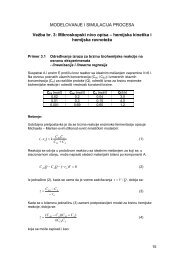1 Matlab solution to diffusion-reaction problems
1 Matlab solution to diffusion-reaction problems
1 Matlab solution to diffusion-reaction problems
You also want an ePaper? Increase the reach of your titles
YUMPU automatically turns print PDFs into web optimized ePapers that Google loves.
The boundary condition at x = 0 (pore mouth) depend on the bulk concentrations of A and B. Theboundary condition at x = 1 (pore end) is the no flux condition for both A and B.The <strong>solution</strong> vec<strong>to</strong>r y has size of four and consists of:⃗y =⎛⎜⎝y 1 = c Ay 2 = dc A /dxy 3 = c By 4 = dc B /dx⎞⎟⎠ (10)The system is now formulated as four first order ODEs for the four components of the <strong>solution</strong>vec<strong>to</strong>r and solved by bvp4c in exactly the same way. Details are left out as homework problem.An important consideration in this type of problem is how the selectivity is affected by pore<strong>diffusion</strong>. The yield of B is defined as:Yield = flux of B out of the pore mouth / flux of A in<strong>to</strong> the porewhich can be stated as:Yield = −(dc b /dx) x=0 /(dc a /dx) x=0 (11)The relative concentration gradients of A and B at the pore mouth determines the local yield of B.A smaller catalyst size is favorable <strong>to</strong> B production. A larger particle traps B in the interior of thepores allowing it <strong>to</strong> react further and form C. This reduces the yield.Maximum yield = (k 1 C A0 − k 2 C B0 )/k 1 C A0 which is also equal <strong>to</strong>maximum yield = 1 − k 2C B0k 1 C A0with C A0 and C B0 representing the pore mouth concentrations.Pore <strong>diffusion</strong> resistance causes the yield <strong>to</strong> decrease from the above maximum value. Maximumyield is realized only at low values of the Thiele parameters.Example simulated with matlab for a particular case illustrates this point. ).Consider φ 1 = 2 and φ 2 = 1. Also c a0 = 1 and c b0 = 0 which may correspond <strong>to</strong> the inlet of thereac<strong>to</strong>r (with no recycle), Yield is found as 0.8067.Now let the catalyst size be reduced <strong>to</strong> one half the original size. Then both φ 1 and φ 2 decrease.The new value of yield is found <strong>to</strong> be 0.8764. Maximum yield is 1 for both of these cases. The pore<strong>diffusion</strong> resistance has decreased the yield but the reduction is even more for the larger particles..Students should verify these using matlab.2 Asymp<strong>to</strong>tic Solution <strong>to</strong> <strong>diffusion</strong>-<strong>reaction</strong> <strong>problems</strong>For a single non-linear <strong>reaction</strong> problem, a <strong>solution</strong> can be obtained analytically for large values ofThiele modulus. This asymp<strong>to</strong>tic <strong>solution</strong> can then be used <strong>to</strong> define a generalized Thiele modulusand can be extended <strong>to</strong> obtain approximate analytical <strong>solution</strong>s even for low Thiele modulus. Thisavoids <strong>solution</strong> by numerical methods and is useful in reac<strong>to</strong>r design where repeated calculation ofthe effectivness fac<strong>to</strong>r at different points in the reac<strong>to</strong>r is often needed. The procedure is illustratedbelow.Consider a model problem represented as:d 2 cD e = f(C) (12)dx2 3


